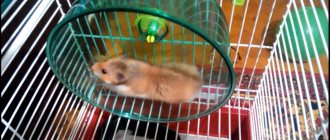- home
- Care
10/20/2018 This question is on the minds of all parents who bought an animal for their children to foster a love of nature and a desire to take care of someone. Hamsters are cute, fluffy, funny creatures that evoke sympathy and affection with their funny habits. However, problems may arise with them if a “biting habit” suddenly appears. So how to stop a hamster from biting?
Common causes of bites
Under natural conditions, hamsters, when faced with something unknown and incomprehensible, instinctively try it out. It is quite natural for an animal to learn and master new things through a bite. However, at home, aggression and bites can be provoked by a variety of reasons:
- danger;
- the smell of food;
- fear;
- a change of scenery;
- pain;
- genetic memory;
- showing affection;
- grinding of teeth;
- pregnancy.
First of all, an aggressive hamster that is not yet familiar with its new owner can get scared and bite. It is quite natural that unfamiliar surroundings and strange smells make a new resident feel unsafe. Over time, exposure to human scents helps calm the hamster. To wean your pet from biting, you should periodically, without sudden movements, bring your hand to the animal’s nose. This way, getting used to the new owner will go much faster. Only after the initial adaptation can you try to pick up the hamster by carefully placing your hand under its tummy.
When hamsters get scared, they usually scream sharply, shrilly, but a plaintive squeak signals confusion. With a characteristic squeal, the animal warns a potential enemy that it intends to defend itself. This is also evidenced by snorting and clanking of teeth. In case of any danger, the hamster will take refuge in a shelter.
If human hands smell like food, this provokes the animal to explore a new object and try it on its teeth. A hamster is unlikely to react to clean, washed hands.
A change in the usual environment can also trigger a hamster to start biting. In this case, everything contributes to stress - the new environment and smells in the cage, excessive attention from family members. You need to give your pet time to explore the cage and toys, and then you can try to give him a treat while gently stroking his fur. Careless, rough touches can harm a fragile creature, cause it pain, and provoke aggression.
If a hamster bites until it bleeds, this may be due to genetic memory phenomena - a hand raised from above is regarded as an attempt to attack from the air. After all, the steppe ancestors of hamsters were often subjected to similar attacks by predators.
The manifestation of friendly feelings and sympathy in these rodents is also expressed by biting. So if a hamster bites and rubs its head against its owner’s hands, this may mean a call for games, showing sympathy.
A feature of the physiology of rodents is the rapid growth of teeth, which periodically need to be ground down. For these purposes, the pet must be provided with plant roots, dry branches, and a chalk stone. Otherwise, the baby will have to try to grind his teeth on his master’s hands.
Aggressive behavior may occur in pregnant females. Being in this state, females become indifferent to games, their mobility decreases, and they are not easy to handle. It is not recommended to show intrusive attention to her; even an examination before childbirth is best done only visually.
If such a nuisance does happen, the pet is bitten until it bleeds, you should not lose your temper, much less shout at the pet or hit it. Such actions will only intimidate the baby, and the adaptation process can take a long time.
First aid for a child if a hamster bites him until he bleeds
https://www.youtube.com/watch?v=emJzsfIpT80
Some tips on what to do if a hamster bites a child:
- Wash the bitten area with warm water and antibacterial soap.
- Treat the wound with an antiseptic. It is best to use Chlorhexidine or iodine, but if you don’t have them on hand, you can moisten the wound with hydrogen peroxide or brilliant green.
- After treatment, seal the wound with adhesive tape. If your hamster bites your finger, you can put on a special rubber finger guard. If necessary, you should give a painkiller tablet.
Do you need to go to the hospital if a rodent bites your baby until he bleeds? If this was done by a pet who perceived playing with him as aggression and decided to defend himself, then there is no need to worry. Suspicion of an animal's illness is a serious cause for concern. If your hamster has been overly aggressive lately or, conversely, lethargic and eating poorly, this may be a sign of illness.
You need to take the bites of hamsters sold in markets or pet stores very seriously. What should you do if an animal bites a child while you are buying it? You need to go to the hospital immediately. You should take the rodent with you so that the laboratory can check whether it is a carrier of the infection.
In this case, a person always needs first aid.
And it consists of such activities as:
- The bite site must be washed with warm soapy water. It is advisable to use laundry soap, since it, among all other types of soap, helps eliminate infections and bacteria.
- After washing the wound, it should be treated with a medical antiseptic. For this purpose, preparations such as a solution of ode, brilliant green, alcohol or hydrogen peroxide are excellent.
- Then, in order to prevent infectious agents from entering the bite wound, it is best to seal it with a bactericidal adhesive plaster. And if the bite occurs on a finger, it will be convenient to use a rubber fingertip while working around the house.
- If an intense painful syndrome develops, you can take a pharmacological agent with an analgesic effect.
Features of handling Campbell's hamsters
Breeds of domestic hamsters are not as diverse as we used to think. Today it is common to breed the following breeds:
- Dzungarian (Sungur);
- Syrian hamsters;
- Angora hamster;
- Roborovsky's hamsters;
- Campbell's hamster.
Campbell's hamsters are one of the most problematic species to keep at home. For a comfortable stay for one hamster, it is enough to purchase a cage measuring 50 by 30 cm. Hamsters are unusually nimble, so the distance between the bars of the grid should not be more than 0.5 cm so that the pet does not escape. It is advisable to provide the animal with a running wheel. Under natural conditions, hamsters are excellent runners and sometimes cover considerable distances, so in a cage they need to receive sufficient physical activity.
Campbell's hamsters are nocturnal, which can be an obstacle to their communication with humans. They become active at night, and by morning they hide back in the house or nest. You can only communicate with them in the evening or early in the morning.
Incredible love of freedom is another characteristic feature of Campbell's hamsters. They don’t like to be picked up and begin to defend themselves and let their teeth in. Experienced owners often remove animals from cages while wearing gloves. However, once in your arms, these hamsters quickly come to their senses, becoming tame and affectionate.
What do Degu squirrels need to be happy?
Food! This is the main thing they need. In general, Degu squirrels are agricultural pests. They live in Chile and destroy crops. It is advisable to always have dry food and hay available. You can also give lettuce leaves, sour apples, etc.
Pet stores sell special food for Degu squirrels. It is dangerous to give food for other animals (for example, rabbits) to Degu squirrels, because Degus are diabetics, and dry fruits containing sugar are added to food for other animals. If it is completely impossible to find food for Degu, you can give food for chinchillas - these animals have a similar diet.
Degu squirrels are quite mobile, so the cage should be spacious. The cage should be high (preferably not even 2, but 3 floors), and it should be wide enough for a jump. Degus, by the way, jump quite high - they can definitely jump 1 meter in height.
Degu squirrels need branches, as well as houses, ladders, etc., made of wood. Of course, they eat it all up, and periodically you have to buy new ones.
A running wheel is required.
Our cage has a double bottom, so we put regular cat litter on the bottom bottom to absorb urine. If there is no double bottom in the cage, you can use sawdust or charcoal as bedding.
The good thing about a double bottom is that sooner or later the Degu squirrels will start gnawing on their cage. And if the bottom is plastic and not metal, they can chew their way out.
In the photo: Degu squirrel
How dangerous are animal bites?
How dangerous the bites of domestic hamsters are is a controversial question. Of course, if the pet has not had contact with other rodents, then it is unlikely to be a carrier of rabies. However, hamsters can be carriers of diseases common to humans, such as:
- tuberculosis;
- listerosis;
- toxoplasmosis;
- meningitis;
- salmonellosis.
Therefore, when a Djungarian hamster bites (or other breeds), if it is aggressive, agitated, or sleeps little, it is recommended to check the animal for infections.
Practice shows that there are very few cases of owners becoming infected with hamsters; it is still recommended to see a doctor if the bite becomes red, itchy or tingling. In other cases, simple treatment of the damaged area is sufficient.
Solving the problem
Every furry owner needs to come to terms with the idea that it is almost impossible to wean an animal from doing this. You can only change the object of its action. Therefore, do not forget to feed not only vegetables and grass, but also tougher foods so that the hamster can wear down his teeth.
Indeed, due to the constant growth of teeth, they will become even more aggravated and injure the hamster’s mouth, and can even lead to his death. If such a situation arises, the veterinarian will be able to shorten the teeth, but this should be done only in extreme cases. Because stitching should be natural.
Another option that will wean the animal from gnawing the cage is to buy twigs, mineral stone, and vitamins for the hamster. Which will not only solve an unpleasant problem, but will also saturate the body with trace elements and beneficial substances. This will require little expense from you, but will bring maximum benefits.
Also, hamsters can chew on bars due to the large amount of energy, and then you just need to increase his load if it is low. This is easy to do: either buy him a large cage, or put a wheel or ball in which he can run.
Method No. 1
Don’t want your fluffy to bother you and decide on his own home? Then buy him something tasty and healthy. In stores you can now find a lot of treats for hamsters, which consist of different products, so you can choose the best option for you. It can be not only chips, but also sets of dried fruits, sprigs of his favorite fruit and much more. Although it is best to choose something harder so that the teeth grind down.
It is necessary to give such a treat to hamsters no more than once a day and most often before bedtime. So that the awake animal has something to do and does not disturb you. If you wish, you can make a similar product yourself using the same recipes as in store-bought treats.
Method No. 2
Don't forget about mineral stones for small rodents. After all, this is not only an effective method of weaning him from gnawing on his cage, but also a way to take care of the rodent’s health. This device looks like an ordinary stone with a high content of useful elements and vitamins for a hamster.
After all, they are very often not enough in the animal’s normal diet. Mineral stone can be purchased at any pet store and will last you a long time. Make sure to attach it to the cage or branches so that the hamster can always see it if he wants.
Method No. 3
In addition to treats for hamsters and stones, you can even make your own twigs for grinding down teeth. For this, you can use various trees, but the main thing is those that do not contain harmful resins that can be toxic to the hamster. If you take small branches, you will simply need to saw off the thorny elements and parts so that the animal does not harm itself. And also secure them in the cage. From time to time, the branches need to be replaced with new ones so that the baby always has something to do.
Method No. 4
You can do it differently and coat the bars of the cage with some unpleasant substance, but not a chemical solution, you don’t want the hamster to die. Use red pepper or lemon juice for this. So that after tasting the cage, the baby will understand that it is not tasty at all and is not worth his attention.
Method No. 5
You can wean your animal off a bad habit not only with stones or treats, but also with a special spray. Although it will only affect those animals that are more sensitive and capricious. But for the majority it will not have the desired effect. Therefore, the effectiveness here is purely individual.
Method number 6
Pay attention when the hamster sharpens its teeth on the cage and in what place. If he does this when he sees you with food or hears you open the refrigerator, then he may just want to eat.
And when he chews on the bars near the exit, he wants to walk free. And after that he won’t bother you anymore.
You need to be very attentive and take care of small rodents, because their desires are much more difficult to understand than a dog or a cat. Use all the tips and arrange a decent home for your hamster with mineral stones, vitamins, treats and twigs. And then you won’t have any problems with him.
Precautions after a bite and wound treatment
So, the Djungarian hamster bites - what to do? As a rule, bites from domestic rodents do not cause much harm to human health, but they can be quite painful. After all, hamsters’ incisors are very sharp and long, growing throughout their lives. Therefore, when bitten, a laceration usually forms, causing pain.
Having received such damage, immediately send the animal to the place and start treating the wound. To do this you need:
- urgently rinse the wound with water at room temperature using an antibacterial cleanser;
- disinfect with any antiseptic;
- cover the wound with a bactericidal plaster;
- if sharp painful sensations occur, take an antispasmodic.
If the temperature increases due to inflammation of the wound, see a doctor immediately.
Defensive reaction
You have a hamster, which you brought into the house, trying to start getting acquainted and communicating as quickly as possible, but why did he bite your outstretched hand?
In such a situation, most rodents do not understand such zeal, as they experience stress from moving, new surroundings, smells and people around them. It is not surprising that Djungarian hamsters bite in an attempt to protect themselves from the unknown. The new resident needs time to adapt, and your attention should be consistent and restrained, this will gradually help you wean the baby from biting.
In addition to stress, remember that the dzhungarik is by nature a wild animal that prefers loneliness
And the new owner’s attempts to show attention and affection, scratch behind the ear or stroke them, are perceived by him as something out of the ordinary.
Khomas are quite aggressive even towards their relatives, energetically defending their territory; it is quite possible that this instinct could transfer to you.
The sooner a small rodent is taught to communicate and given pleasant gifts in the form of various goodies served by hand, the less likely there is for such a problem to arise.
If you have adopted a dwarf that is older than two months, be prepared for the fact that it may be necessary to wean it from biting.
Which breed smells less?
Those who want to have a cute rodent at home often ask whether Djungarian hamsters stink, and which breeds smell less. It has already been decided that healthy, calm animals do not emit any unpleasant odors. Their feces smell bad, and not immediately, but when they accumulate for several days in one place.
It is logical that a large animal will produce more of these feces than a small one. This is the simplest explanation why Syrian hamsters’ cages need to be cleaned more often than small dwarf hamsters.
Overgrown teeth
Experienced owners are well aware that Djungarian hamsters, like many other breeds, have constantly growing teeth. Therefore, they need to be constantly ground down. The cage must contain suitable twigs (preferably from fruit trees), mineral stones or suitable roots. The hamster will happily chew on them, grinding down their teeth to an acceptable size.
If he does not have this opportunity, his teeth may grow so long that he will not be able to close his mouth or eat. In this case, without the help of a veterinarian, the rodent is doomed to a slow and painful death. Therefore, there is nothing strange in the fact that in the absence of suitable objects for grinding teeth, your pet begins to chew everything it can reach. Fingers – yours or those of your loved ones – will be no exception.
What to do if none of the tips help?
It often happens that owners regularly follow all the recommendations for caring for the animal and communicating with it, but the animal does not make contact and continues to bite. In such a situation, you may find that you have a Campbell's hamster living at home.
These rodents are considered one of the most problematic in terms of communication with humans . Some individuals completely refuse to accept their owners for the rest of their lives and constantly bite their hands when trying to establish contact. These hamsters are often confused with Djungarian hamsters. It's quite easy to distinguish them:
Unusual smell from hands
Another fairly common problem that can provoke a hamster who has lived in your family for many months, knows and loves all its members very well, is smell. Although their eyesight is not the best (in dense grass or underground it is still not very useful), they can boast of an excellent sense of smell. Therefore, a smell that you do not notice seems quite distinct to him. And the aroma that you rate as pungent may seem simply disgusting to him.
Of course, it will not be possible to protect against this 100%. But if a hamster bites you, try to analyze the situation - did you cut garlic shortly before the attack, did you get lotion or perfume on your hands, did you use scented soap. Usually, if the smell is familiar, it will be associated with the owner and will not cause the hamster to panic. But if you suddenly decide to change the strawberry-scented soap to a mint counterpart, this can confuse the hamster, making him think that it was not his beloved owner who took him out of the cage, but a completely unfamiliar stranger. In such a situation, from his point of view, aggression is not just justified, but the only right decision. However, he can bite in the opposite situation - for example, if you rubbed a carrot in the kitchen and decided to pick up the hamster in your arms. Having smelled its favorite treat, the rodent may well decide to taste your finger.
Territorial distribution
Many species of living beings in nature are capable of supporting the persistence and spread of infection. The United States and Canada are famous for the widespread incidence of the disease in raccoons, foxes, jackals and skunks. Many species of bats carry the rabies virus, which can infect others in African countries, Australia, and areas of Europe and Asia.
The typology of rabies is divided into two types - natural and urban foci of spread. In nature, frequent carriers are foxes, wolves, arctic foxes, bats or mongooses. The urban environment is dominated by cats, dogs and farm animals.
It is noteworthy that there is not a single case of rabies among rodents with subsequent transmission of the virus to humans. However, there is an unconfirmed theory that rodents may be reservoirs for carrying and perpetuating the infection, which are distinguished by their ability to avoid death for several days after infection.
In matters of protection against the rabies virus, it is necessary to take an immediate response to bites, and pets must be vaccinated to eliminate the threat of the disease. This approach is explained not only by the danger of the disease, but by its widespread prevalence, since only Antarctica and some island territories, which include Japan, Malta and Cyprus, as well as New Zealand, are protected from infection. Surprisingly, the infection has never been recorded in Finland, Sweden, Portugal and Spain.
How does a hamster become infected with rabies?
Rabies (rabies) is a deadly disease. A person or animal that exhibits clinical symptoms is doomed and dies within a decade or less. However, in order for a hamster to get sick, several conditions are required simultaneously:
- The area must be unfavorable for rabies. The reservoir of infection is wild carnivores, mainly foxes. They bite livestock, but more often cats or dogs. Theoretically, it is possible to become infected without a bite if the saliva of a rabid animal gets on the abrasion or in the eye.
- The hamster must interact with wild rodents and be bitten by them. Of the creatures inhabiting the house, these are only mice. A bite from a rat or cat will kill a small creature. In turn, the mouse must also become infected from someone.
It is known that the rabies virus may not manifest itself in any way for 10–90 days. Therefore, the possibility of acquiring an infected rodent and displaying aggression several months later cannot be ruled out. In short, the probability of an ornamental hamster becoming infected with rabies is vanishingly small, but not zero. If a hamster lives in an apartment for more than three months, has never escaped from the cage, and suddenly starts biting, then this is not rabies, but another reason.
Stages of taming an animal
The question posed in the title, how to wean a hamster from biting, is closely related to the question of taming an animal to a person, to his hands. How to gain the trust of a little hamster? Let's look at how best to do this step by step.
- Take something tasty and put it in the cage without removing your hands. Your movements should under no circumstances scare the baby. Look at his reaction: perhaps he will come close and want to sniff your hand to remember the smell. Don’t pull your hand away, even if he bites it – just for testing. Be patient and try not to scare him with sudden movements.
- If everything went without complications, taming can continue. Let’s complicate the task: the yummy treat is already in the palm of your hand, extended to the animal in a friendly manner. Wait until he climbs on it and starts eating. After some time, you can allow yourself a little affection - lightly stroke the hamster’s back with your finger without touching the head.
- Once you are sure that the previous lesson has been learned, you can continue. Now, having placed the animal in the palm of your hand, we take it out of the cage. Do this carefully: he is so small, if you exceed the force, you can easily damage something to him. Especially warn children about this: let them measure their tenderness with the fragility of the animal.
As you can see, everything is quite simple: you only need patience and delicacy so that the problem of how to stop a hamster from biting stops bothering you.
And finally, we will list the actions that are unacceptable towards a hamster and to which he will be forced to respond with a bite.
Never touch your hamster's head . Avoid this movement.
Do not take him from behind - in a position where he does not see you. It's stressful for him. He must first see a familiar hand and then he will calmly react to your touch.
Don't punish your hamster! Physical punishment will not stop him from biting. Only love and patience can explain to an animal that this cannot be done.
Please rate the article
4.5925925925926 Rating 4.59 (81 votes)
We will be very grateful if you share it on social networks. Thank you!
Comments
+19 Serious_Pro_Hamster_Gamer :3 01/23/2014 20:36 A good way to wean a hamster! I personally like this method!
Reply | Reply with quote | Quote | Report to moderator
+4 Vlada and Khoma 02/17/2014 07:27 Is it normal for a hamster to try to drag hay into the wheel before running around in the wheel?
Reply | Reply with quote | Quote | Report to moderator
+10 Hamster Crunchy! 02/17/2014 14:32 Probably wants to make a nest there. It happens that they are whimsical and can do it anywhere. It's OK. His cage, he will figure out where to live and where to run
Reply | Reply with quote | Quote | Report to moderator
+1 Vlada and Khoma 02/26/2014 18:09 Thank you
A retrospective look at the virus
The infection was first recorded in dogs and described by Democritus back in the 5th century BC, and already in the 1st century AD, the rabies virus was discovered in humans, giving it the definition of hydrophobia. The disease is transmitted easily and quickly from animals to humans through bites. At first, it was recommended to cauterize wounds to prevent infection on the surface of the wound. Only at the end of the 19th century was the first vaccine against the rabies virus developed.
Modern medicine uses this development, combining it with two anti-rabies drugs: serum and immunoglobulin. The doctor injects deep into the wound and injects the substance into the soft tissue around the wound. The high effectiveness of the vaccine depends on the time of seeking help after bites. Accordingly, the sooner a bitten person is vaccinated, the more likely the success of recovery. The situation is similar for pets: a problem noticed in time will allow your pet to be successfully treated.
Just a decade ago, the dangerous virus was considered an incurable disease, and after the first symptoms appeared, hopes for recovery were zero. Innovations in the field of medicine have made it possible to step forward and doctors are happy to record cases of recovery at the symptomatic stage. We cannot say that the disease has been completely defeated; it still remains one of the most dangerous infectious diseases of the body, because out of 37 people, only 5 people were lucky enough to be successfully cured. After being bitten, especially by street or wild animals, do not neglect going to the hospital or veterinary clinic, which can subsequently save the health and life of you and your rodent.











